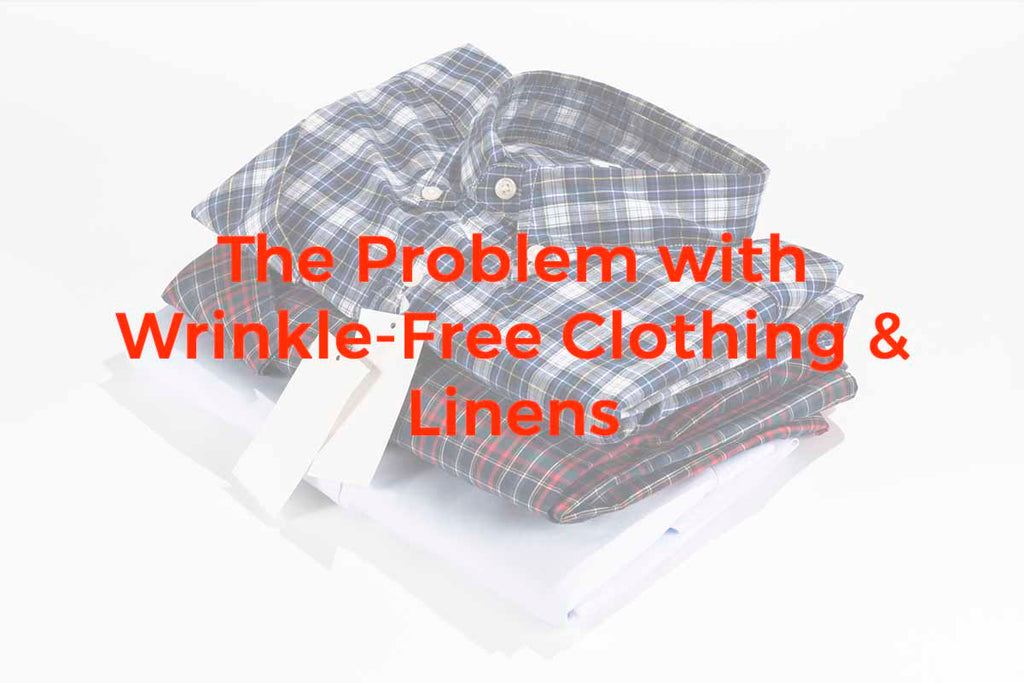The Problem with Wrinkle-Free Clothing & Linens

You can find wrinkle-free shirts, pants, and linens with the alluring appeal of looking crisp right out of the dryer. However, like some good things, there is a catch. Anti-wrinkle fabrics can release formaldehyde, which is not good for you. It's smart to understand the risks for yourself, factory workers, and the environment. It may not be time to retire your iron after all.
No-Iron Shirts Release Formaldehyde
When making fabrics with an anti-wrinkle finish, manufacturers use a resin that can leak formaldehyde during manufacturing, wearing, and washing. The resin is used to keep the fabric's fibers in place during washing for that crisp, ironed look. The downside is that these garments may be releasing unhealthy levels of formaldehyde that you can breathe or absorb through your skin.
Formaldehyde in Anti-Wrinkle Fabrics is Not Regulated in the US
The US does not regulate formaldehyde levels in fabrics. Fortunately, other countries in Europe and Asia have put restrictions on the amount of formaldehyde used, resulting in healthier levels of formaldehyde used today in clothing and linens sold globally. Japan's regulations are the most stringent.
A government study from several years ago, tested 180 items and the majority of them had low or undetectable levels of formaldehyde using Japan's standards. Although about 6% of the items tested (wrinkle-free shirts, pants, pillow cases, crib sheets) exceeded the standards.
The problem is you have no way of knowing if your no-iron shirt or your infant's crib sheet is safe. The study did not offer recommendations, but the researchers reported that they now wash their no-iron clothing before wearing.
Sadly, washing may not be the answer. One small study showed that after two washings, the majority of fabrics still contained the same formaldehyde content.
Dangers of Formaldehyde
Formaldehyde isn't good for you. Whether you are exposed to formaldehyde by breathing the fumes or absorbing it through your skin, it can cause skin irritation, nausea, respiratory distress, and cancer.
As you can imagine, factory workers suffer the greatest exposure. However, many consumers are also affected. People who wear no-iron clothing can suffer from allergic contact dermatitis. These people can become sensitized to formaldehyde perhaps through other formaldehyde exposure and can react to even low levels in clothing.
Your Indoor Air & Formaldehyde
No-iron clothing and linens aren't the only sources of formaldehyde exposure. You can also be exposed through a laundry list of household items including pressed wood furniture and cabinets, paint, wallpaper, and laminated wood flooring. In addition, cooking with gas and using your wood-burning or gas fireplace exposes you to formaldehyde.
In fact, the EPA states that formaldehyde levels in homes and offices are 20 to 200 times higher than outdoor air. Learn how to reduce your exposure to formaldehyde using some simple steps.
Pure Living Space's Products Never Contain Formaldehyde
At Pure Living Space, we're dedicated to providing the cleanest, safest products. None of our bedding contains any formaldehyde, but you may need to find your iron if you want that crisp look!




